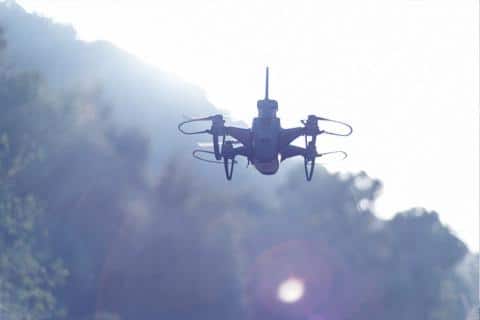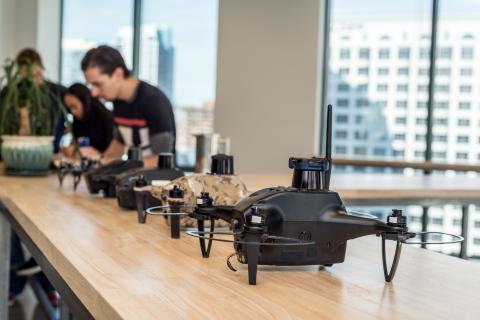[September 13, 2018]
What is Machine Intelligence?

What is Machine Intelligence?
The term Artificial Intelligence (AI) is very prominent in mainstream media, causing the initials to often be used without full comprehension of the meaning. AI’s ability to capture the imagination is hardly new. There are movies reflecting on AI as far back as 1927 with Metropolis and continuing to present day; including, of course, the 2001 aptly named film, A.I. Artificial Intelligence.
Machine intelligence is its own form of intelligence with its own specialties compared to human intelligence or other animal intelligence. Modern machine intelligence is a combination of imitation (i.e. artificial intelligence), self-learning, extrospection, and introspection.
At Shield AI, we develop robotic machines with the autonomy to efficiently maneuver in the world and the intelligence to semantically understand their environment for better execution of the mission and the best information gathering possible.
Decomposition of Robot Intelligence
Today, one of the classes of machine that we care about at Shield AI is the robot. The minimum requirement for basic robot intelligence is the autonomy process, while the intelligence process is necessary for robust handling of challenging new environments.
Autonomy is the conversion of sensor data into structured information for processing by predefined cognitive strategies that lead to decision and action. Intelligence is the capacity to learn new cognitive abilities to add semantic understanding to the sensor data for the purposes of improved decision making during the cognition step of the autonomy process. An intelligent system can use its higher-level understanding to perform self-directed autonomy and curated ground truth gathering. Full robot intelligence uses an autonomy process with a cognition step that is augmented by intelligence.
The autonomy process of robot intelligence starts with state estimation and mapping, where the sensor information is used to estimate the state of both the robot and the environment. In this step, the data from various sensors is processed and filtered into a prediction of the current state of the robot — position, orientation, velocity, and acceleration. This concept of the state only makes sense relative to some frame of reference, so the system must also build a map to give context to the state. When we, as humans, move through an environment, we use objects as a reference; we might use walls inside or the sidewalks and street signs outside. If we are going on a road trip, we might route the trip in a global frame. In the autonomy process, we create and update a map based on the perception of the environment and the current predicted state of the robot.
The next phase of the autonomy process is to deliberate on the available information and reason about the appropriate action. An accurate estimate of the robot state in the map representation allows the system to use its mission-based strategy to decide on the next goal and then plan a path. The system can then use control methodology to ensure precise movement to achieve the trajectory. This autonomy process achieves robot intelligence that will navigate through an environment following a predictable pattern because the strategies are all predetermined.
The intelligence process of robot intelligence provides a set of cognitive abilities to provide semantic understanding to the perceived view of the environment and to the predicted state of the system, both of which can influence the decision step of the autonomy process. Examining and understanding the environment around the platform is extrospection. The modern approach is to develop data-driven models of particular classes of objects and environments that can be used to detect those classes in application. Combinations of trained classifiers can be used to understand details of the environment that might aid in execution of the mission. For example, the ability to detect an exit allows the system to continue exploring the entirety of an indoor space rather than exiting through an open window.
Analyzing the system in terms of the contrast between the predicted state and the known abilities is introspection. The modern approach is, again, to develop data-driven models, but for the application of understanding the performance of the sensors, the health of components, and the changing abilities of the system given the environment. The result allows the system to adapt strategy to failing internal hardware or swap autonomy modules that perform better in specialized situations. An easy example is when the system detects failing health, it may adjust the exploration to reduce strain or it may exit to safety.
Beyond Deep Learning
The models for the intelligence process are trained using Machine Learning (ML), which is a broad field of computer science that is readily used across the sciences and engineering. At its simplest, ML is the process of adapting weights of a model over some number of iterations to converge on a model-weights pair that best represents the training data. This is not substantially different from fitting signals to curves, which has been done for many decades. The difference is that modern computing allows for ML techniques that can fit more complex models to larger data sets and broader problems than single signals.
The rebranding of neural networks as deep learning has led to a huge resurgence in research and application of the learning approach. It is important to note that it is not just a rebranding, as it did involve some breakthroughs in back-propagation techniques, activation functions, and computing that allowed for enough layers (depth) to drive results. And these initial results have led to amazing research that has continued to push what is possible in data-driven learning of models for a wide range of applications.
There is a lot more to ML than deep neural networks. There is a whole range of learning approaches that have different benefits and drawbacks; and some techniques favor different types or amounts of data. It takes full understanding of the underlying math — linear algebra, probabilities, statistics, multivariate calculus, etc — to devise the ML approach that is suited for a particular problem. Even with that understanding, deep neural networks inherently have so many layers that the activations of deeper layers are not easily consumed by humans. This leads to research to better visualize those layers so we can understand to what the model is actually fitting.
At Shield AI, we think about the use of artificial intelligence beyond deep learning and consider the history of traditional model fitting concepts in machine learning. Our focus is developing intelligent systems for collecting ground truth on demand that are able to understand the semantics of external environments and introspect about internal capabilities, thus leading to adaptable autonomy for mission success.









